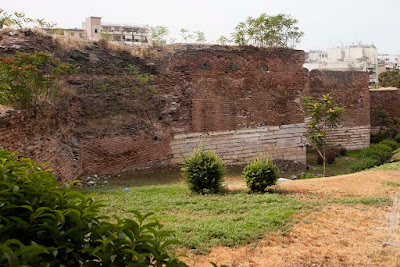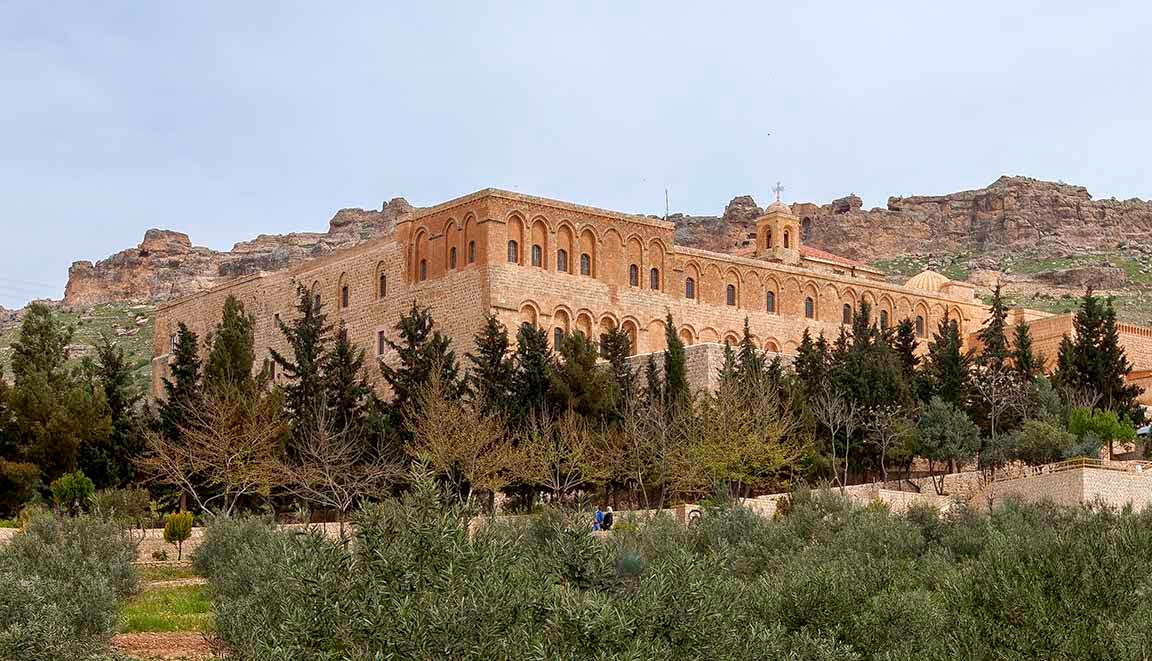The train left Athens on time at 7:18 a.m. and arrived at the train station on the western outskirts of Thessaloniki forty-six minutes late at 1:27 p.m. According to my GPS my hotel near the center of the city was nine-tenths of a mile away. I had planned to walk, but that morning in Athens I had checked the weather forecast and discovered that temperatures were expected to reach 100º F. by mid-afternoon. The forecast for the next day was 105º F., which would tie the highest temperature on record for the date. There was a long line of taxis at the train station, and after being staggered by the heat when I stepped off the train I was sorely tempted to take one, but I finally decided to stick to my original plan and walk. I had this fantasy of entering the city on foot through one of gates in the fourth-century walls around the city, as if I was a humble pilgrim wandering through the domains of Byzantium. Of course if I started feeling queasy from the heat I could always hail a taxi.
Following the arrow on my GPS through several side streets and alleys I finally arrived at the Letalia Gate, which was one of the four major entrances to the ancient city. The monumental tower that housed the gate is long gone, although the ruins of the old fourth century walls can be seen to the north and south.
 |
| Fourth Century walls to the south of the old Letalia Gate (click on photos for enlargements) |
 |
| Fourth Century walls to the north of the old Letalia Gate |
Busy Agiou Demetrioui, one of the main east-west trending streets through the city, now runs through the gap in the city walls. Just inside the walls, to the south, can be seen the domes of the 14th century Church of the Apostles, one of the fifteen or so Byzantine-era churches in Thessaloniki that have survived to the present day. Had I been a fourteen century pilgrim I probably would have headed straight to the church to give thanks for my safe arrival in the city, but now I was more concerned with getting to my air-conditioned hotel. I will return however. I am visiting Thessaloniki not on business nor because, as one web site claims, it is the “hippest city” in Greece, chock full of boutique hotels, chi-chi cafes, trendy restaurants, and overflowing bars and discos, but instead to wander at random and daydream among the city’s Roman, Byzantine, and Ottoman-era monuments and ruins. In short, I am an unapologetic antiquarian and an unrepentant flâneur.
I proceed east along Agiou Demetrioui until the arrow on my GPS veered sharply to the right, then turn south on Ionos Dragoumi. After a few blocks I arrive at the Pella Hotel, named, presumably, after the town of Pella, the birthplace of Alexander the Great, located twenty miles west-northwest of Thessaloniki. Reviews on the internet damn this place with faint praise; it is “adequate”, “acceptable”, “simple but clean”, “good for an overnight stay”, etc. Back in the 1950s it may have been a pretty ritzy joint. Now it appears to be the haunt of lower-tier traveling salesmen, down-market tourists, and grubby backpackers splurging on a bed, shower, and air-conditioning. The receptionist was certainly cordial. I was a bit taken back by her effusiveness; for a second I had the strange sensation that I had been here before and that she were welcoming me back. Unusual for a hotel in the Eurozone, she did not ask for any ID. Despite the warm welcome I am exiled to the seventh floor, but I heave a sigh of relief when I see the perfectly adequate desk and chair and the nearby electric outlets. At least I can work comfortably on my computer. The narrow single bed is, in a word, acceptable, and the pillow is firm and chunky and can do double duty as a meditation cushion. The air-conditioning works and there is even a small balcony. After storing my portmanteau in my room I walk down Ionos Dragoumi to the harbor area and then turn left on the esplanade along the sea.
 |
| Aristotelous Square, which extends north from the Esplanade |
 |
| The Esplanade |
Finally I reach the statue of Alexander the Great (356 b.c–323 b.c.) One of Alexander the Great’s generals, Cassandros, founded this city in 316 b.c. and named it after his wife Thessalonica, who was the daughter of Philip II of Macedonia and Alexander’s half-sister. Alexander was the son of Philip and the notoriously snake-loving Olympias (so memorably played by Angelina Jolie in the 2004 epic
Alexander), while Thessalonica was the daughter of one of Philip’s other wives. Alexander the Great had, of course, died seven years earlier in Babylon, so he never got to see the city named after his half-sister Thessalonica.
 |
| Alexander the Great |
 |
| Alexander the Great |








